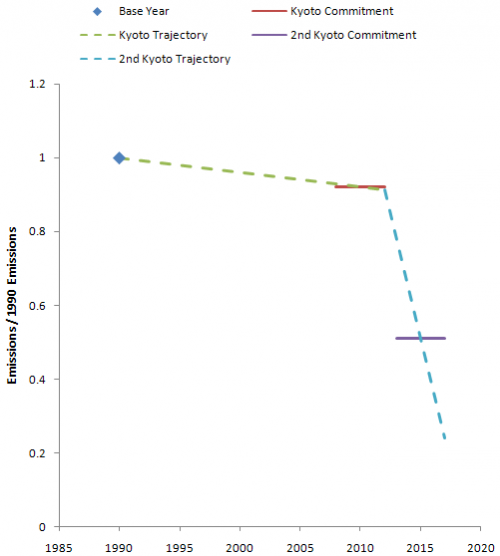I’ve added the Dec. 16 Kyoto Protocol working group draft to my summary table.
There’s not much to report with respect to the global outcome. Most of the detail is focused on Annex I (developed) country commitments. There are so many options and brackets in the text that it’s hard to draw any concrete conclusions about the implied emissions trajectory.
There’s possibly an interesting disconnect around characterization of the second round of targets. Currently there are a number of options included in bracketed text. First, the endpoint could be either 2017 or 2020. Second, various options suggest a range of cuts between 15% and 49% below 1990. This range corresponds roughly with the range typically cited as providing a decent chance of hitting a 2C target (see AR4 WG3 Ch. 13 box 13.7, pg. 776, for example).
If you think back to the first Kyoto agreement, countries committed to small cuts relative to 1990 for a commitment period from 2008 to 2012. For the EU, with an 8% cut, that meant averaging 92% of 1990 emissions over the commitment period. If you imagine that emissions fall along a linear path from 1990, that means that emissions at the midpoint (2010) would be 92% of 1990, and emissions would be a little higher prior to that, and lower after. Because the slope from 1990 through 2012 is shallow, a viable trajectory would include a 7% cut in 2008 and 9% in 2012. No big deal.
However, for the next commitment period, the slope is a very big deal. The deepest cut in the AWG-KP draft is 49% for the developed world. I suspect that number is anchored on upper end of the AR4 2C range (25-40%), moved up a bit. 49% still sounds plausible. But there’s a problem: to achieve a 49% average over 2013-2020, starting from a 9% cut in 2012, you’d have to do one of two things: reduce emissions an additional 37% overnight, then keep them there (basically impossible), or reduce emissions by 13 percentage points per year, arriving at a cut of 76% in 2017. That’s a year-on-year reduction rate of 15 to 35% per year. That’s pretty tough going, given that, even if you never build another bit of carbon-emitting capital, natural turnover takes you down at 2 to 5% per year.

I’m all for strong targets, but abandoning capital at 10% per year is going to be a tough sell. It’s not clear to me that this is intentional. I think it’s quite possible that misperception of the dynamics of a target accumulated over an interval leads to false conflict, as desire to achieve a point goal (e.g., -40% in 2020) is confused with a much more stringent goal over a long interval.

1 thought on “The AWG-KP draft”